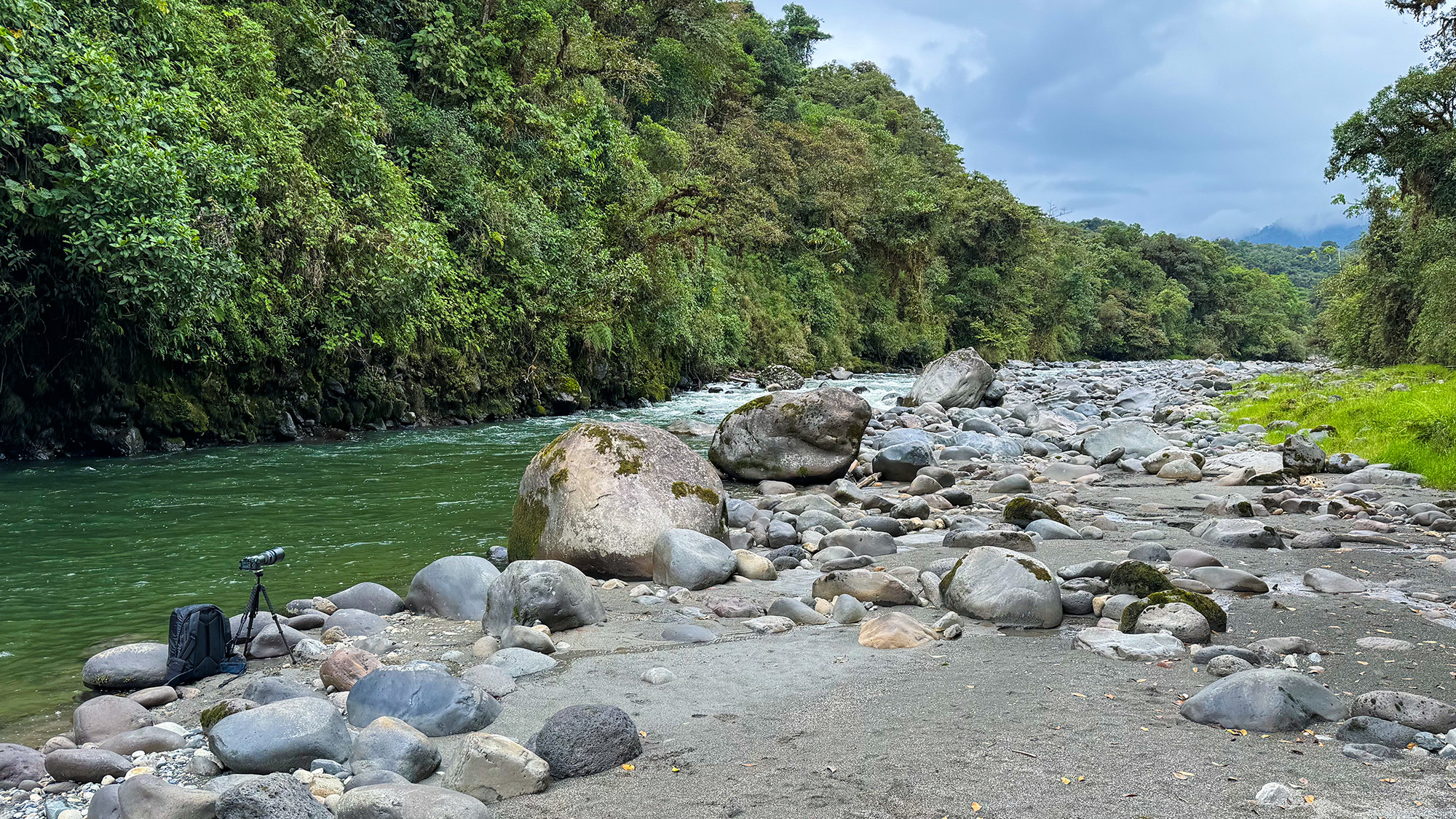
After years of using another brand, I found myself with a new camera backpack: the Peak Design Travel Backpack 45L (hereafter referred to as PDTB). This might seem like a sudden change, especially for someone who has relied on Shimoda backpacks for so long. Questions arose: Why move away from Shimoda? Why not consider other reputable brands like F-stop, Gitzo, Tenba, Mindshift, or LowePro? This review will delve into my journey, answering these questions and more, much like a self-interview addressing the queries I’ve received about this transition. So, grab a coffee and join me as I explore my experience with the Peak Design Travel Backpack 45L.
ACKNOWLEDGEMENT: I want to extend my sincere gratitude to the Czech representative of Peak Design for providing me with the backpack for testing. Their support and excellent service are greatly appreciated. By: Petr Bambousek, Professional Wildlife Photographer.
THE SHIFT: Why Now?
Is it really that surprising? For some, handbags are a passion; for others, it’s camera backpacks. I fall into the latter category. While I may not understand the handbag craze, I’ve owned my fair share of camera backpacks – around six to eight, if I’m counting correctly. My backpack history started in the DSLR era with models like the LowePro Rover 450 AW II, LowePro Vertex 200, LowePro PhotoSport 200 AW II, Vanguard Uprise 46, and Manfrotto Bumblebee 220. Transitioning to the Olympus/OM System in 2016 marked a shift in my backpack choices as well, leading me to the ThinkTank Airport Essential, Shimoda Explore 30L, and now, the Peak Design Travel Backpack 45L. Three backpacks in the Olympus era might sound excessive, but considering the rigorous adventures each has endured, it feels justified. My trusty ThinkTank accompanied me on 12 tropical expeditions, while the Shimoda Explore 30L joined me on 16. Remarkably, these veterans are still in working order, bearing testament to their durability, though naturally, showing signs of use. I anticipate my new Peak Design backpack will follow suit, maintaining my average of one backpack per four years and approximately 14 expeditions – a pace I consider quite reasonable for a professional wildlife photographer.
ESSENTIAL BACKPACK CRITERIA
What exactly do I look for in a camera backpack? This is a crucial question. Defining your needs is paramount when selecting any gear, especially a backpack. As a nature photographer focusing on subjects from the smallest insects to the largest mammals, I carry a substantial amount of equipment. This necessitates specific requirements for space and functionality in a camera backpack. My key criteria are:
- Carry-on Compatibility: It must meet airline carry-on size restrictions.
- Lightweight Design: The backpack itself shouldn’t add unnecessary weight.
- Modular System: Essential for customizable organization.
- Ample Capacity: Must accommodate all my gear and various accessories.
- Self-Standing: A practical feature for easy access in the field.
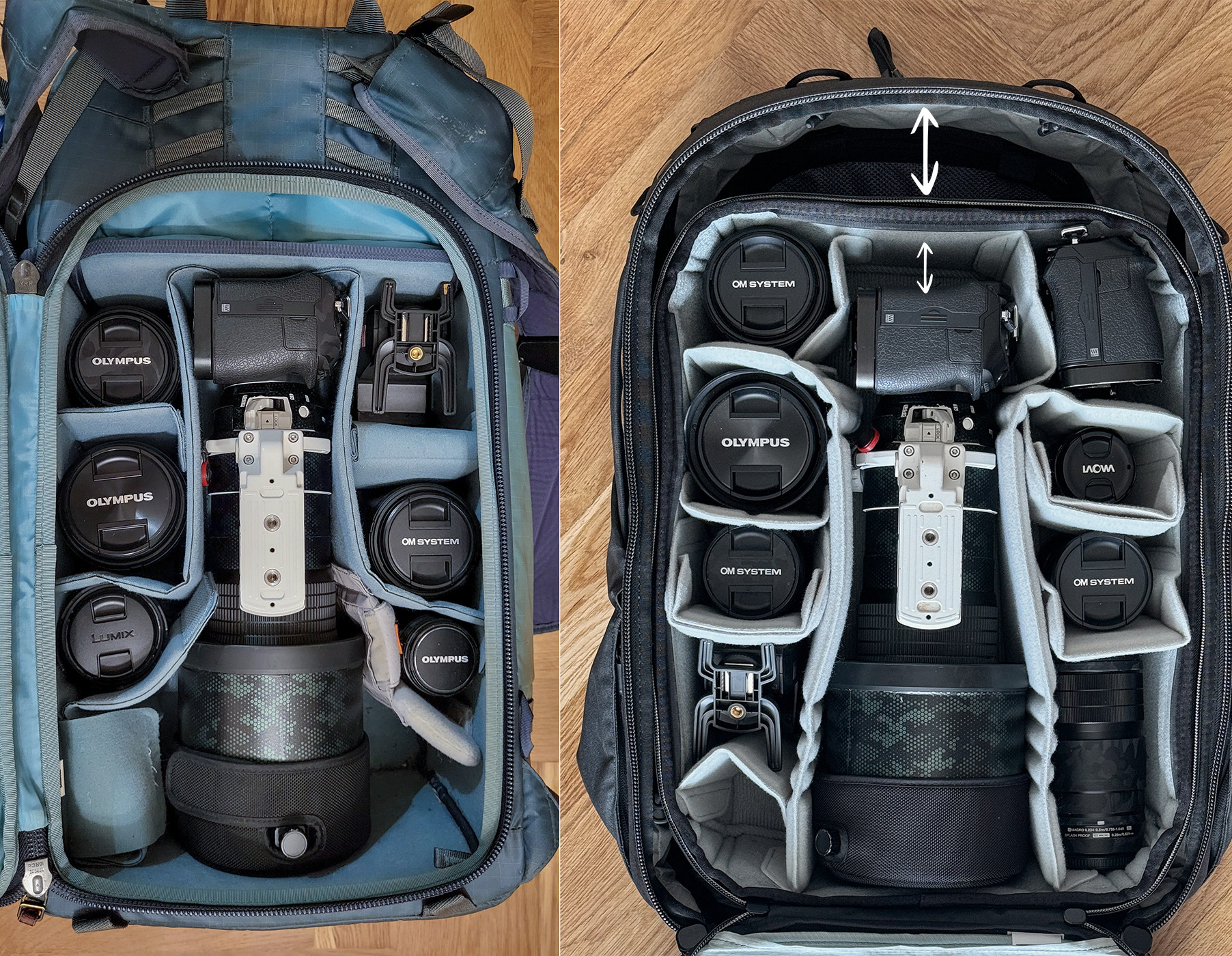
Comparing Shimoda Explore 30l and Peak Design Travel Backpack 45l size. Both camera backpacks are designed to meet airline carry-on requirements. The Peak Design model offers a slightly wider and deeper profile, providing extra space for accessories and gear.
- Back Panel Access: I find back-opening backpacks more convenient for my workflow.
- Comfortable for Extended Wear: Crucial for long days in the field.
- Waist Belt: Essential for weight distribution and support.
- Durable Materials: Built to withstand demanding travel conditions.
- Aesthetic Appeal: While function is paramount, I also want a backpack that looks good.
SHIMODA EXPLORE 30L: Satisfaction and the Need for More Space
Was I dissatisfied with the Shimoda Explore 30L? Absolutely not. In fact, I was very happy with it. Four years ago, when I was initially looking, the Shimoda Explore 30L and the Peak Design Travel Backpack 45L were the frontrunners based on my requirements. I even visited a store, gear in tow, to compare them directly. Both backpacks impressed me, sharing key features: similar size, self-standing design, modular system, back access, and appealing aesthetics. Shimoda excelled with its comfortable straps and sufficient space for my gear at the time using the Large DSLR core unit, ultimately winning my favor. Back then, the Peak Design model lacked a waist belt, which was a deal-breaker for me.
However, fast forward four years, and Peak Design now includes a waist belt with the Travel Backpack 45L! Discovering this felt like a revelation. The belt is ingeniously concealed, almost invisible when tucked away. This update significantly changed the landscape. Choosing the Shimoda Explore 30L back then was a solid decision, serving me well for years. But as my gear evolved, so did my needs. The addition of bulkier items like the OM 150-400mm/4.5 TC (affectionately nicknamed “Gandalf”), macro focusing rails, and larger flash diffusers began to push the Shimoda’s capacity to its limit. Everything fit, but just barely. Gandalf, my primary lens, was a tight squeeze, causing wear on the eyecup. The diffusers were even more problematic – two fit reasonably, but the third, larger one required bending to fit. Simply put, the backpack had become too small, prompting my search for a replacement.

The Peak Design Travel Backpack 45l in action in the field, showcasing its suitability for travel and outdoor photography.
My first thought was to explore the updated Shimoda Explore 30L. While the new version boasted many improvements, a crucial issue arose: the larger core unit I now required was incompatible. This meant I’d have to size up to an even bigger backpack, which I wanted to avoid. Furthermore, the roll-top design of the Action X series, while practical, didn’t align with my aesthetic preferences. This led me to reconsider my previous second choice – the Peak Design Travel Backpack 45L. I had kept an eye on this backpack, especially since a frequent travel companion, Zdeněk Macháček, used it and spoke highly of it. Personal consultations and YouTube reviews further confirmed that the backpack indeed had a waist belt. My earlier misconception was clearly my mistake.
My affinity for Peak Design products runs deep, starting with the Anchor Links and Slide strap, and expanding to a wide array of their accessories, all of which I highly value. I even dedicated a Czech article to my Peak Design collection. Leveraging my positive relationship with the Czech Peak Design representative, I requested a test unit of the Travel Backpack 45L. Again, THANK YOU – this hands-on experience was invaluable in making my final decision. Had it not met my needs, I would have explored other options like F-stop, Gitzo, or Mindshift. However, my gut feeling, combined with my excellent experience with Peak Design, guided me towards this backpack. And so, the testing phase began.
THEORY OF GEAR TRANSITION
The quest for the “perfect” gear is a common struggle. Photographers often write to me, anxious about making the “right” choice, fearing a better option might exist. I’ve observed a common, often subconscious, expectation when changing gear: everything should remain the same, yet somehow be better. However, my experience, both with cameras and backpacks (and perhaps even life partners), suggests this isn’t how transitions work. Each piece of gear possesses unique attributes that others lack. This often triggers an internal debate: “This one has feature X, but that one has Y… but this one has Z, which the other doesn’t…” We create lists of pros and cons, often comparing apples to oranges, leading to frustration and decision paralysis. I faced this eight years ago when I initially switched systems, until I had an epiphany. I decided to shift my approach. Instead of comparing the old with the new, I would embrace the design philosophy of the new manufacturer. I would immerse myself in their intended use of the product, observe its real-world performance, and identify any genuine limitations. Only then would I form judgments and seek solutions for any shortcomings. For a few days, I operated under the premise that no other backpack existed. I carried my gear as usual, packed and unpacked, explored different equipment configurations, and wore the backpack constantly – essentially, using it in my everyday photography workflow.
GEAR MIGRATION TO THE PEAK DESIGN TRAVEL BACKPACK
The first step was emptying my Shimoda backpack. After four years of use, it was quite revealing to see just how much “essential” gear I had accumulated. Packing everything into the new Peak Design Travel Backpack 45L, while ensuring accessibility, was the next challenge. Beyond my camera equipment, I always carry a PD Slide strap, PD Capture Clip, phone in a PD case, PD wallet, PD Cuff wrist strap, PD spare plate, PD Anchor Links, PD hex key (yes, I’m a Peak Design enthusiast!), a Leofoto mini tripod, VFFOTO magnetic polarizer, Canon remote cable release, mini reflectors for macro, Megapixel memory card case, business card holder, sensor cleaning kit, optical wipes, spare batteries, and my keys. Each item needs a designated, easily accessible spot, even in low light conditions. In the Shimoda, the top pocket served this purpose, but it quickly became congested. With the PDTB, I distributed these items across multiple pockets, and the backpack absorbed everything without appearing overstuffed. It was immediately apparent how practical it was to have tools, plates, and Anchor Links on the right side, straps on the left, and less frequently used items like cleaning kits in the upper section of the main compartment. Everything had its place, and the backpack maintained a streamlined profile even when fully loaded.
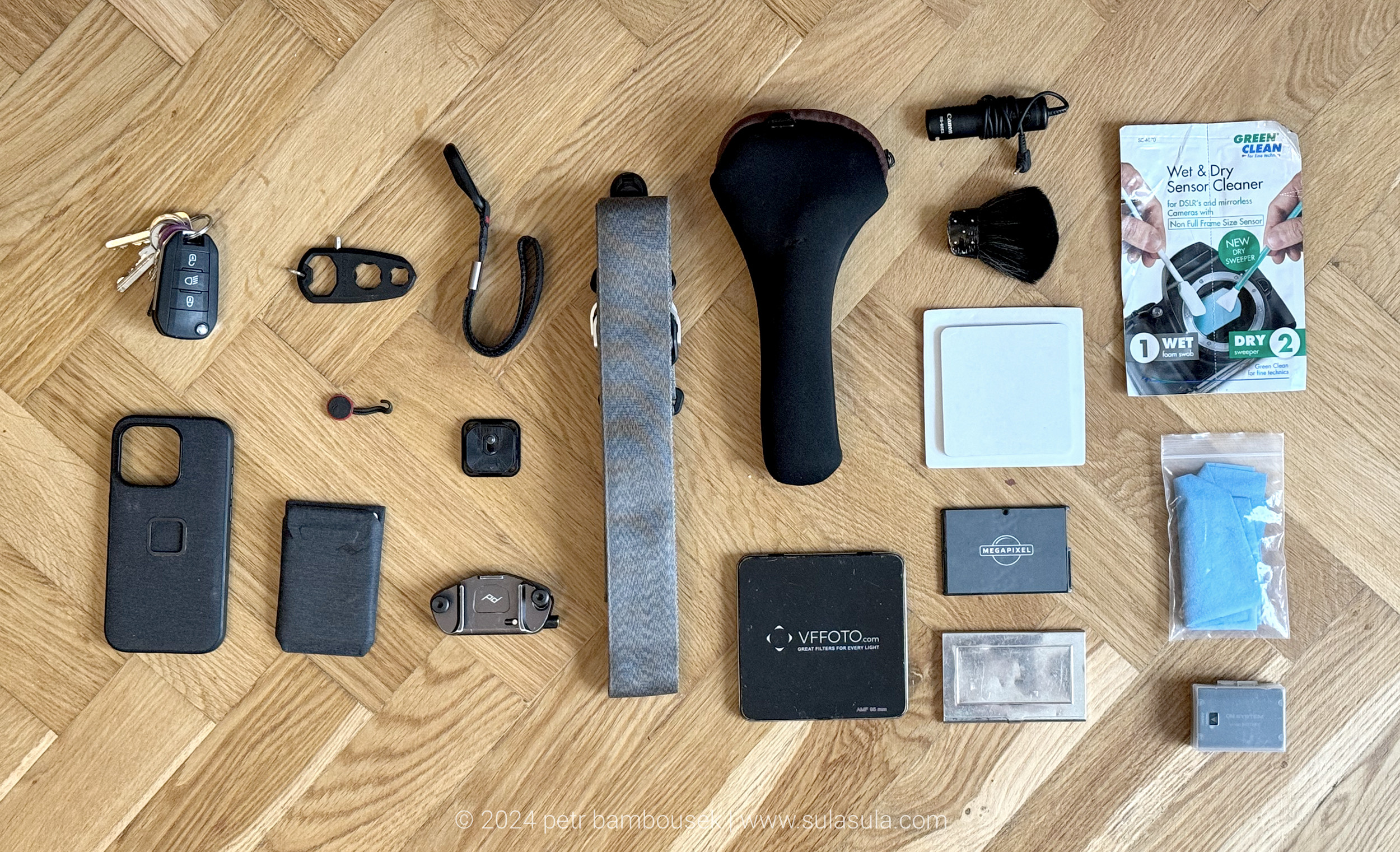
Essential accessories that I keep readily accessible in my camera backpack at all times. These items are non-negotiable for my photography workflow.
Next came organizing my camera gear. My standard setup includes two camera bodies (one usually mounted on Gandalf), seven lenses, a Godox V350O flash, and a Godox XPro II trigger (likely to be upgraded to the X-3 version soon). I also need to accommodate my macro rails in their protective case and find a safe storage solution for my diffusers. After some strategic arrangement, everything found its place seamlessly. The Peak Design Camera Cube Large core unit provided ample space. Gandalf, with the camera body attached, had about 3cm of clearance, perfect for easy insertion and removal. The space between the core unit and the backpack’s top comfortably housed my macro rail case. When not needed, this space accommodates my strap and mini tripod. My diffuser case then nestled perfectly on top, without being compressed. The laptop compartment, unused for its intended purpose, became home to my foldable outdoor mat, and my tablet fit neatly in the large front pocket. The zippers closed effortlessly, without any forcing. While I don’t always carry this full load, it’s reassuring to know the Peak Design Travel Backpack 45L can handle it with ease when necessary.
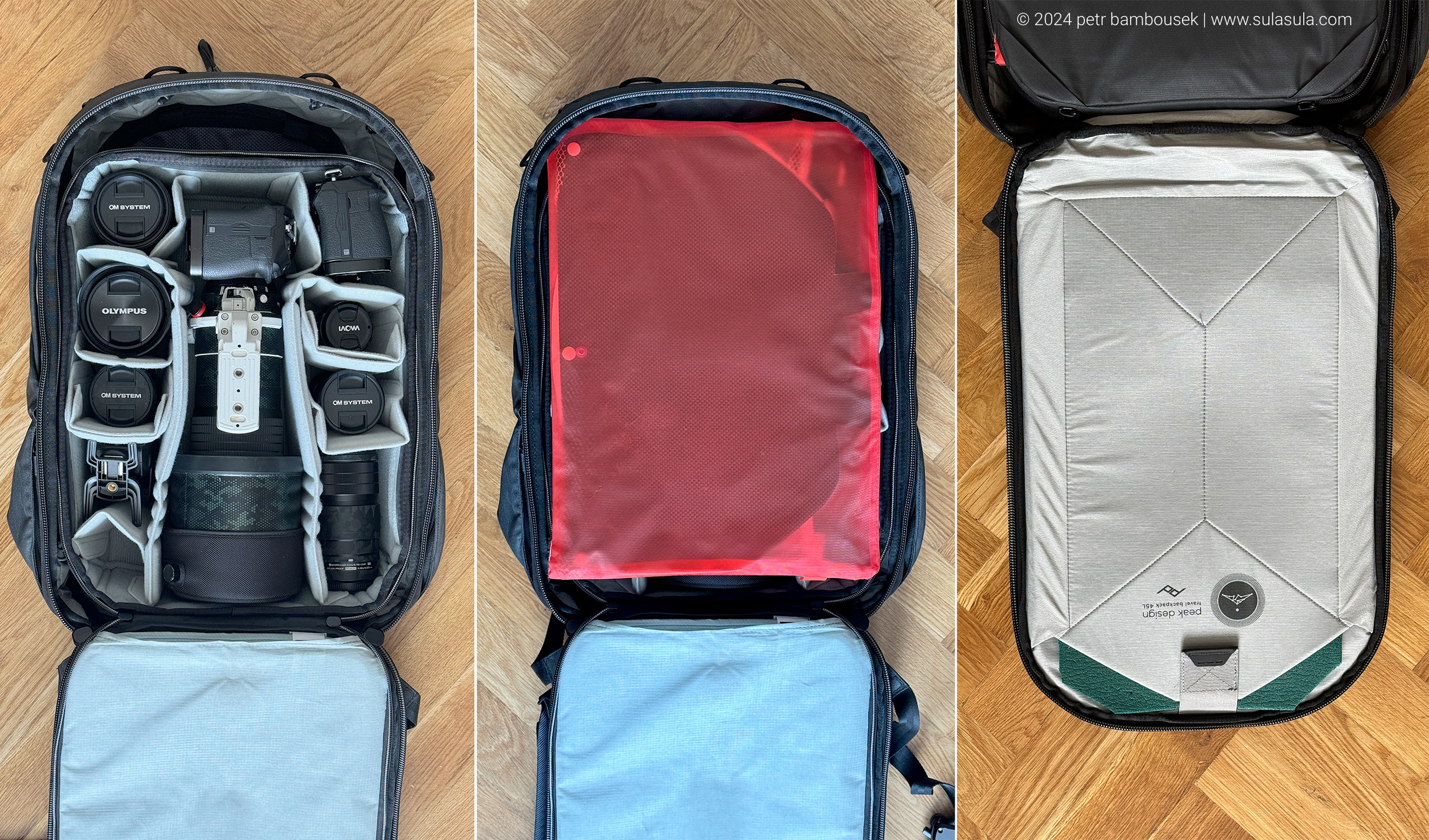
Full gear capacity of the Peak Design Travel Backpack 45l (left). Center image shows the placement of a set of three diffusers. Right image shows the placement of a foldable mat inside the backpack.
The front pocket is remarkably spacious. I experimented with its use for my tripod, water bottle, and jacket – items I frequently need when trekking through tropical rainforests. While side pockets are an option for the tripod and water bottle, I find it throws off the backpack’s balance, especially as the water bottle empties. The large front pocket comfortably accommodates all three, allowing me to redistribute weight as needed for optimal balance. After several test trips and some fine-tuning of smaller accessory placement, everything settled into place. For demanding hikes, the included rain cover, stored in a dedicated bottom compartment, provides excellent protection. Beyond rain, it shields the backpack from thorns, rocks, and mud, preventing unnecessary wear and tear. Unlike my previous rain cover with the Shimoda, this one is truly waterproof. Overall, the backpack and I quickly became acquainted, and any initial concerns dissolved. After returning the Sage-colored test unit, I purchased my own in Black.
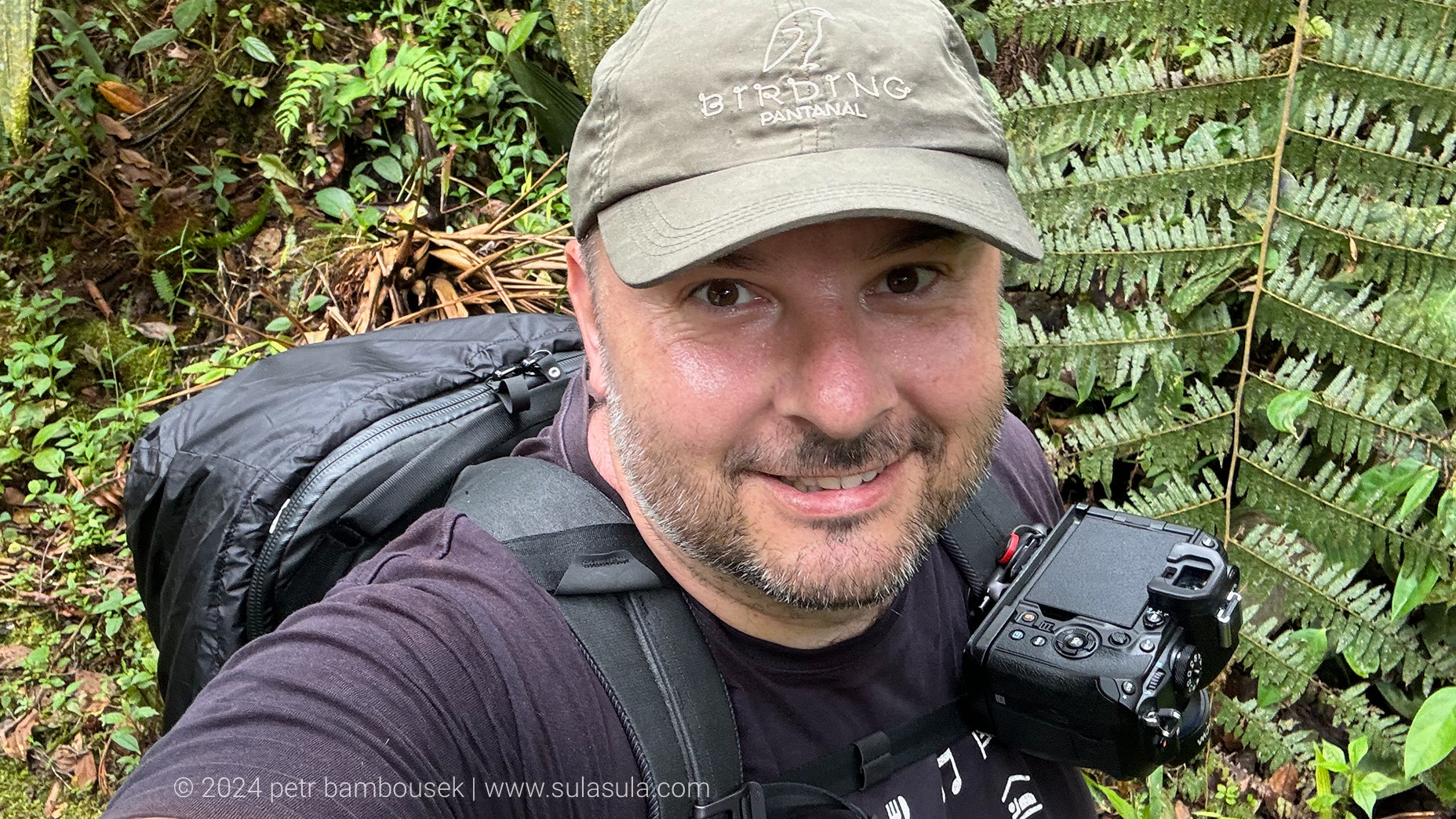
Exploring the Ecuadorian rainforest with the Peak Design Travel Backpack 45l. The main camera is safely stored inside, while the backup camera is readily accessible on the Peak Design Capture Clip.
REAL-WORLD PERFORMANCE IN ECUADOR
Following the testing phase, my planned trip to Ecuador became the ultimate field test for the Peak Design Travel Backpack 45L. Before departure, I addressed a few minor issues that had surfaced during testing. Peak Design is renowned for its innovative and thoughtful design, earning them numerous accolades, and my admiration. However, I felt the chest strap mechanism was slightly over-engineered (though manageable with patience), and particularly the waist belt buckle design. The sleek metal hook and loop closure, while aesthetically pleasing and minimalist, proved less practical in fast-paced field situations. Imagine spotting a rare bird in the rainforest – you need to quickly remove the backpack and grab your camera. Fumbling with a hook and loop under pressure is less than ideal. Similarly, after capturing the shot, you want to quickly re-secure the backpack and move on, without needing to precisely engage the hook again. While visually appealing, this design felt cumbersome. I opted for traditional snap buckles, replacing the original closures within minutes.
Another minor inconvenience was the lack of strap pockets for keys and a phone. With the Shimoda, I was accustomed to locking the car, slipping keys into one strap pocket and my phone into the other, and setting off. The PDTB lacks this feature. I addressed the phone issue by adding a LowePro external phone pocket. Designed for larger phones like the iPhone Pro Max, it’s slightly oversized for my standard iPhone Pro, but functional. Ideally, Peak Design would release their own phone pockets in various sizes, designed to integrate seamlessly with the backpack (two sizes would likely suffice). The key issue remains partially unresolved. The waist belt, which I don’t always use, includes a small pocket. So, after locking the car, I now place my keys in the convenient top front pocket of the PDTB before putting the backpack on.
My final observation concerns the straps. Shimoda’s straps are undeniably more robust. In fact, a store clerk cautioned me that Peak Design backpacks are “more for city strolls.” I disagree with this generalization. As mentioned, a travel companion regularly uses the PDTB on demanding expeditions, including rainforest hikes, without issue. My own intense trip to Ecuador, where the backpack was my constant companion, confirmed that the straps are perfectly adequate and comfortable for demanding use. While other backpacks may offer more substantial straps, it doesn’t negate the many strengths of the Peak Design Travel Backpack 45L. Overall, I am extremely pleased with my new camera backpack. It excels at organizing my extensive gear in a remarkably compact form factor, meeting and often exceeding my requirements. Upcoming trips to Brazil’s Pantanal and Indonesia will be further tests, but I’m confident in its performance.
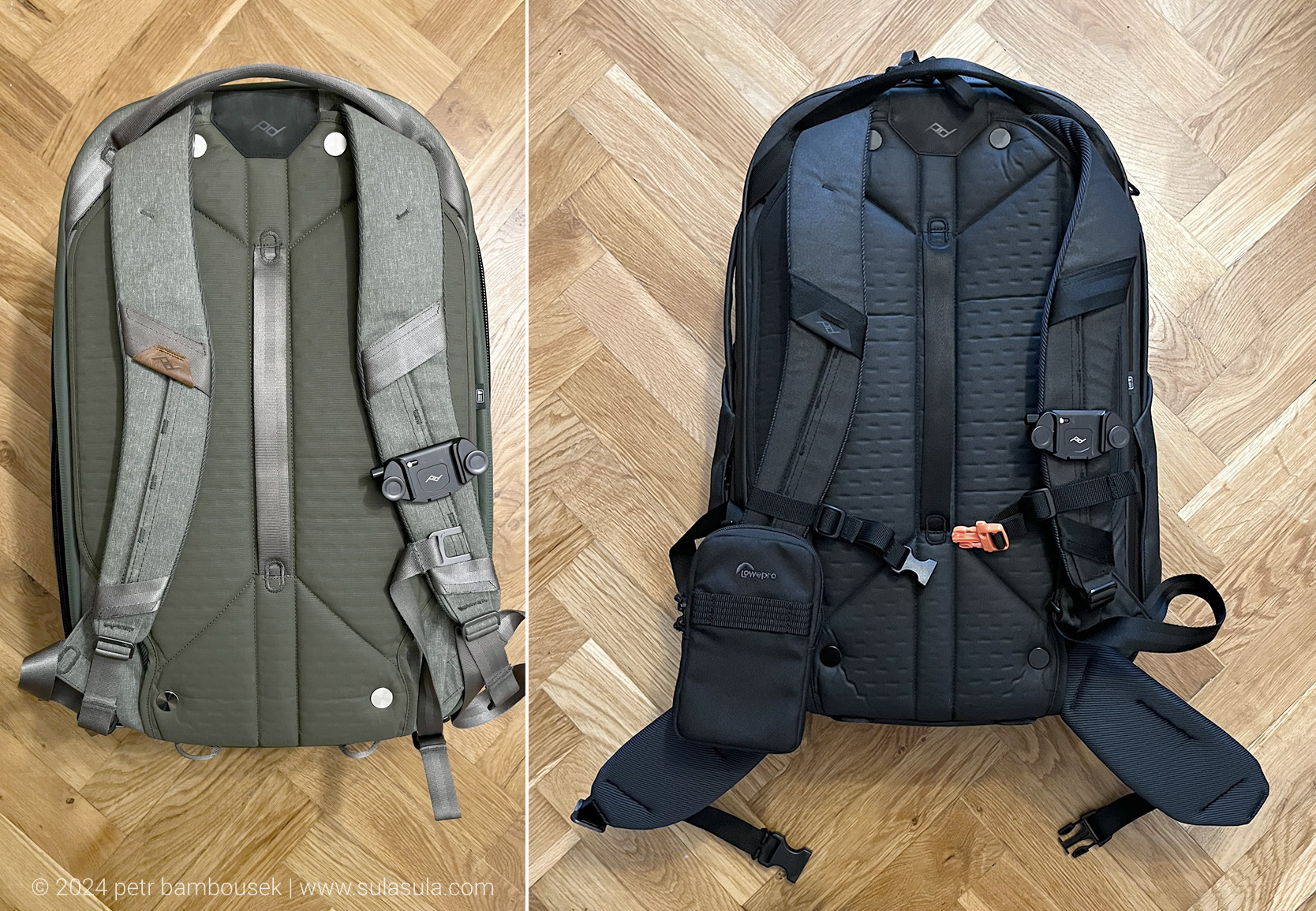
The Peak Design Travel Backpack 45l’s waist belt can be cleverly concealed within the back padding, a feature that initially led to my mistaken belief that it lacked a waist belt. The right image showcases my modifications to the black version: replacing the original chest and waist belt closures and adding a phone pouch. Peak Design phone pockets would be a welcome addition to their Mobile lineup.
KEY HIGHLIGHTS OF THE PEAK DESIGN TRAVEL BACKPACK 45L
The Peak Design Travel Backpack 45L is packed with intelligent features. For a comprehensive overview, I recommend watching this YouTube video. Personally, these are the most compelling aspects:
- Adjustable Capacity: The base 35L capacity is remarkably compact, expandable to 45L (which I haven’t needed) or compressible to 30L.
- Concealable Straps: Both waist and shoulder straps can be stowed away, transforming it into a streamlined duffel.
- Adjustable Back Panel: The back padding can be increased, though in tropical climates, ventilation systems are often ineffective for me.
- Optimal Depth: It comfortably accommodates the OM 150-400mm/4.5 lens with its tripod foot without digging into my back, yet remains within airline carry-on depth restrictions.
- Hidden Pockets: Discreet pockets for stashing accessories.
- Comfortable Back Panel: Fits my back perfectly and provides excellent support.
- Abundant Attachment Points: Loops strategically placed for securing external gear.
- User-Friendly Zippers: Large, robust zippers that operate smoothly with one hand.
- Self-Standing Design: Stands upright for easy access.
- Aesthetic Appeal: Simply put, I find it visually appealing!
Explore the full range of Peak Design products at: www.peakdesign.com
Petr Bambousek
OM SYSTEM AMBASSADOR | Professional Wildlife Photographer with over 20 years of experience and 40+ expeditions to tropical rainforests worldwide. My work has been featured in exhibitions, online platforms, and numerous magazines and books, both in Czech Republic and internationally. Awards include Czech Press Photo, Nature’s Best Photography, Bird Photographer of the Year, Sony World Photography Awards, Big Picture Awards, Nactus Awards, and Wildlife Photographer of the Year, where a finalist image became a central promotional piece for the 2015 traveling exhibition. For more of my photography, please visit my Photogallery and connect on my Facebook profile.

